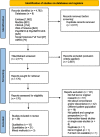Decision-making in palliative care: patient and family caregiver concordance and discordance-systematic review and narrative synthesis
- PMID: 35318213
- PMCID: PMC10804031
- DOI: 10.1136/bmjspcare-2022-003525
Decision-making in palliative care: patient and family caregiver concordance and discordance-systematic review and narrative synthesis
Abstract
Background: Decision-making in palliative care usually involves both patients and family caregivers. However, how concordance and discordance in decision-making manifest and function between patients and family caregivers in palliative care is not well understood.
Objectives: To identify key factors and/or processes which underpin concordance and/or discordance between patients and family caregivers with respect to their preferences for and decisions about palliative care; and ascertain how patients and family caregivers manage discordance in decision-making in palliative care.
Methods: A systematic review and narrative synthesis of original studies published in full between January 2000 and June 2021 was conducted using the following databases: Embase; Medline; CINAHL; AMED; Web of Science; PsycINFO; PsycARTICLES; and Social Sciences Full Text.
Results: After full-text review, 39 studies were included in the synthesis. Studies focused primarily on end-of-life care and on patient and family caregiver preferences for patient care. We found that discordance between patients and family caregivers in palliative care can manifest in relational conflict and can result from a lack of awareness of and communication about each other's preferences for care. Patients' advancing illness and impending death together with open dialogue about future care including advance care planning can foster consensus between patients and family caregivers.
Conclusions: Patients and family caregivers in palliative care can accommodate each other's preferences for care. Further research is needed to fully understand how patients and family caregivers move towards consensus in the context of advancing illness.
Keywords: communication; family management; methodological research; supportive care; symptoms and symptom management; terminal care.
© Author(s) (or their employer(s)) 2023. Re-use permitted under CC BY-NC. No commercial re-use. See rights and permissions. Published by BMJ.
Conflict of interest statement
Competing interests: None declared.
Figures
Similar articles
-
Mutual support between patients and family caregivers in palliative care: A systematic review and narrative synthesis.Palliat Med. 2021 May;35(5):875-885. doi: 10.1177/0269216321999962. Epub 2021 Apr 2. Palliat Med. 2021. PMID: 33794713 Free PMC article.
-
How do Patients With Advanced Cancer and Family Caregivers Accommodate One Another in Decision-Making? Findings From a Qualitative Study in Specialist Palliative Care.Am J Hosp Palliat Care. 2025 May;42(5):452-458. doi: 10.1177/10499091241255117. Epub 2024 May 16. Am J Hosp Palliat Care. 2025. PMID: 38756049 Free PMC article.
-
Palliative care experiences of adult cancer patients from ethnocultural groups: a qualitative systematic review protocol.JBI Database System Rev Implement Rep. 2015 Jan;13(1):99-111. doi: 10.11124/jbisrir-2015-1809. JBI Database System Rev Implement Rep. 2015. PMID: 26447011
-
Discordance among patient preferences, caregiver preferences, and caregiver predictions of patient preferences regarding disclosure of terminal status and end-of-life choices.Psychooncology. 2015 Feb;24(2):212-9. doi: 10.1002/pon.3631. Epub 2014 Aug 7. Psychooncology. 2015. PMID: 25099223
-
Decision-making among patients and their family in ALS care: a review.Amyotroph Lateral Scler Frontotemporal Degener. 2018 May;19(3-4):173-193. doi: 10.1080/21678421.2017.1353099. Epub 2017 Aug 11. Amyotroph Lateral Scler Frontotemporal Degener. 2018. PMID: 28799808 Review.
Cited by
-
Family Experiences of Loss and Bereavement in Palliative Care Units during the COVID-19 Pandemic: An Interpretative Phenomenological Study.Healthcare (Basel). 2024 Sep 4;12(17):1763. doi: 10.3390/healthcare12171763. Healthcare (Basel). 2024. PMID: 39273788 Free PMC article.
-
'That's why I wanted him to go on dialysis' - a qualitative inductive thematic analysis of older patients' and their family members' perspectives on kidney failure treatment decision-making.BMC Nephrol. 2025 Jul 9;26(1):368. doi: 10.1186/s12882-025-04275-0. BMC Nephrol. 2025. PMID: 40634848 Free PMC article.
-
Advance care planning.Clin Med (Lond). 2025 Jul;25(4):100339. doi: 10.1016/j.clinme.2025.100339. Epub 2025 Jun 18. Clin Med (Lond). 2025. PMID: 40553899 Free PMC article. Review.
-
Elements of End-of-Life Discussions Associated With Patients' Reported Outcomes and Actual End-of-Life Care in Patients With Pretreated Lung Cancer.Oncologist. 2024 Feb 2;29(2):e282-e289. doi: 10.1093/oncolo/oyad245. Oncologist. 2024. PMID: 37669003 Free PMC article.
-
End of life decision making when home mechanical ventilation is used to sustain breathing in Motor Neurone Disease: patient and family perspectives.BMC Palliat Care. 2024 May 2;23(1):115. doi: 10.1186/s12904-024-01443-1. BMC Palliat Care. 2024. PMID: 38698397 Free PMC article.
References
Publication types
MeSH terms
LinkOut - more resources
Full Text Sources

